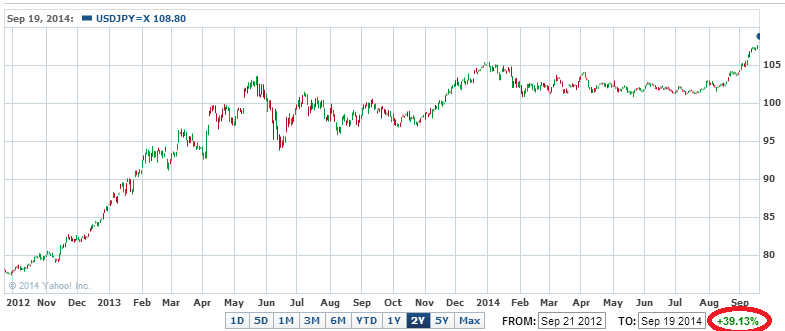Industrial Automation & Sensors Blog
110 Yen: How Japan’s Systematic Currency Devaluation is Affecting Automation Suppliers
The devaluation of the Japanese Yen was one of the biggest global macro-economic themes affecting automation suppliers in 2013. As the picture for 2015 comes into focus, the Bank of Japan (BOJ) looks to continue its role in manipulating global markets.
The Japanese economy has been mired in stagnation since the early 90s due to a confluence of factors including aging demographics, poor oversight, a high level of debt to GDP, and the emergence of China as an electronics manufacturing powerhouse. The currency had appreciated during this period rising to about 80 USD/JPY in the 2011 timeframe. Since then, Prime Minister Shinzo Abe was elected and with him brought a host of policy changes in an effort to jumpstart the Japanese economy. Japan’s “Abenomics” program is similar to the Quantitative Easing program that the US has undergone in recent years; however the program was about 3 times larger in relative comparison. This effort to unwind the strength of the Yen has worked to some degree but the policy’s effect on the economy still remains to be seen. I have compiled a chart below, courtesy of Yahoo Finance, which illustrates the drastic change in USD/JPY over the last 2 years.

As is evidenced from the data, the change is extremely significant with an almost 40% change in just two years. This foreign exchange rate change greatly improves the pricing power of Japanese exporters. Companies such as Yokogawa, Keyence, and Panasonic now have a large advantage over both American and European firms. The impact of this change affects all automation component suppliers since Japanese firms are able to offer an additional 10, 20, and even 30 percent or higher discount on their products with little material effect to their bottom line after accounting for FX. European manufacturers who have a heavy presence selling into US markets have been hurt the most and profitability amongst these firms remains a key issue. Manufacturers need to start developing effective strategies to counteract these trends.
The BOJ has signaled that it will take additional measures in order to support the Japanese economy which hints at further easing and devaluation of the Yen. In preparation of this reality, both American and European manufacturers must develop sales strategies that focus on selling value. Customers also respond well to suppliers who can offer the full solution. Japanese suppliers of sensors and automation components tend to be a relative black box. The components typically do not integrate well with technologies and products from other vendors that may use different protocols or wiring methods. Japanese products also are generally off the shelf and the firms tend to avoid developing custom engineered products for their customers. PNP versus NPN is one example, however Japanese products generally have a limited amount of communication protocols that can be used.
As automation systems begin to encompass more of the manufacturing landscape, end users will be looking for flexible products that they can easily integrate into existing topology. New trends such as the Internet of Things, as well as the proliferation of Manufacturing Execution Systems (MES), will change the practice of suppliers locking in their customers. American and European firms can differentiate from their Japanese competitors by offering customizable solutions that can integrate easily with other systems.
The success of the Abenomics program within the Japanese economy is still uncertain; however the effects within the global macro-economic picture are apparent and unmistakable. As the yen continues to depreciate, American and especially European firms need to take this into account. The currency will touch 110 USD/JPY, and eventually could trade to even 120, or 130 within a few more years. Automation suppliers across all disciplines, whether selling sensors, PLCs, or even software, must develop new sales strategies in order to preserve revenue and margin against their formidable and artificially advantaged Japanese competition.
View the 2019 Industrial Cybersecurity Research Outline to learn more.